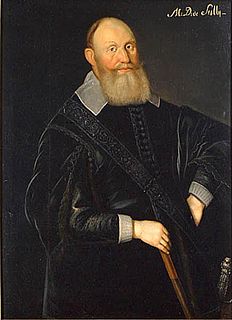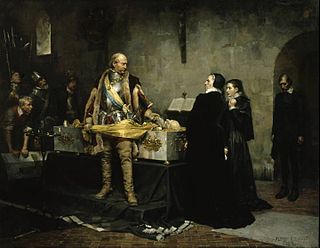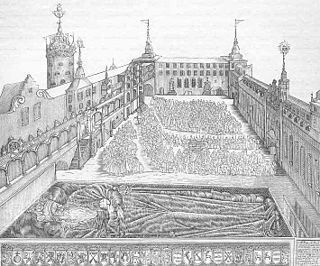This page is based on this
Wikipedia article Text is available under the
CC BY-SA 4.0 license; additional terms may apply.
Images, videos and audio are available under their respective licenses.

Baron Carl Carlsson Gyllenhielm was a Swedish soldier and politician. He was made a baron (friherre) in 1615, appointed Field Marshal in 1616, Privy Councilor in 1617, Governor General of Ingria in 1617 and served as Lord High Admiral from 1620 until his death.
The Cudgel War was a 1596/97 peasant uprising in the kingdom of Sweden. The name of the uprising derives from the fact that the peasants armed themselves with various blunt weapons, such as cudgels, flails and maces, as they were seen as the most efficient weapons against their heavily armoured enemies. The yeomen also had swords, some firearms and two cannons at their disposal. Their opponents, the troops of Clas Eriksson Fleming, were professional, heavily armed and armoured men-at-arms.

Admiral is a naval rank in Sweden. According to current practice only royals and the Supreme Commander of the Swedish Armed Forces, if he were to come from the Swedish Navy, can hold the rank of a full, four star, Admiral (amiral) in Sweden. The lower admiral's ranks currently existing are: Vice admiral, Rear admiral and Rear admiral /Flotilla admiral. The rank of Rear admiral /Flotilla Admiral was added on 1 July 2000, and simultaneously promotions to the rank Kommendör av 1. graden were discontinued. One to three star admirals are all addressed as "admiral" in daily speech.

HSwMS Clas Fleming was a mine cruiser of the Swedish Navy from World War I until the Cold War. She was named after the 17th century Swedish admiral Clas Fleming.
Erik Joakimsson Fleming (1487–1548) was Finnish noble, a Councilor of State of Sweden and an admiral. He was a prominent statesman and King Gustav Vasa's favourite. He was the king's trusted official in Swedish Finland.

The Louhisaari noble family, otherwise known as Fleming or Flemming, is a Finnish family of medieval frälse.
Klas Fleming may refer to:
Måns Nilsson Kling or Mauno Kling was the second governor of the 17th century colony of New Sweden, which he administrated from Fort Christina, now Wilmington, Delaware.

Clas Larsson Fleming was an Admiral and administrator involved in the development of a formal management structure for the Royal Swedish Navy under King Gustav II Adolf and Queen Christina. He is remembered as one of the ablest administrators in the history of the Swedish navy, and is in many ways a typical example of the type of aristocrat who served the Swedish Crown during the period of Sweden's imperial expansion.
The Lord High Admiral or Admiral of the Realm was a prominent and influential office in Sweden, from c. 1571 until 1676, excluding periods when the office was out of use. The office holder was a member of the Swedish Privy Council and the head of the navy and Admiralty of Sweden. From 1634, the Lord High Admiral was one of five Great Officers of the Realm.

Ebba Gustavsdotter Stenbock was a Swedish noble. She led the defense of the stronghold Turku Castle for the loyalist of Sigismund III Vasa during the Siege by Charles IX of Sweden in succession of her spouse Clas Eriksson Fleming, (1530-1597), governor of Finland. The sister of queen Katarina Stenbock, she married Clas Eriksson Fleming, (1530-1597), governor of Finland, in 1573.
The Åbo Bloodbath of 10 November 1599 was a public execution in the Finnish town of Turku (Åbo), then part of the Kingdom of Sweden, in the context of the War against Sigismund and the Club War. Sweden was by then in the final phase of a civil war, with one faction supporting king Sigismund III Vasa, who also was king and Grand Duke of Poland-Lithuania, and another faction supporting duke Charles of Södermanland, the later Charles IX, Sigismund's paternal uncle. After winning the upper hand in the dispute, Charles crushed the last resistance to his rule, particularly in Finland, while Sigismund had already retreated to Poland.
Arvid Stålarm, actually Arvid Eriksson (Stålarm) till Lindö i Tenala was a Swedish noble and soldier from the Finland-based Stålarm family. He is sometimes called "the Younger" to distinguish him from his grandfather and namesake who died in 1529.
Fleming is a surname, likely indicating an ultimate descent from a Flemish immigrant - though this might be so remote that no record of it remains other than the name.

Henrik Klasson Fleming was a member of the Swedish nobility and admiral, diplomat and lord marshal. He was the author of one of the first autobiographies in Swedish, a colourful depiction of his early life which he wrote for his children in a moralising purpose.
Events from the year 1530 in Sweden

Events from the year 1592 in Sweden

Events from the year 1644 in Sweden

Events from the year 1597 in Sweden










